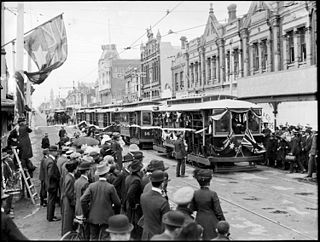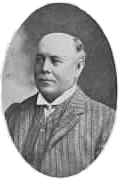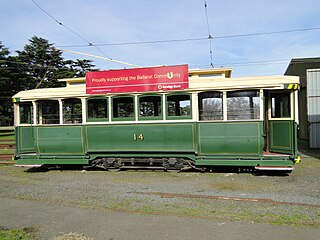Related Research Articles

The Melbourne tramway network is a tramway system serving the city of Melbourne, Victoria, Australia. The tramway network is centred around the Melbourne central business district (CBD) and consists of approximately 1,700 tram stops across 24 routes. It is the largest operational urban tram network in the world and one of the most used, with more than 500 trams and 250 kilometres of double tram track. It served a patronage of 206 million over the year 2017-2018. Trams are the second most utilised form of public transport in Melbourne after the city's metropolitan commuter railway network.

Melbourne tram route 112 was operated by Yarra Trams on the Melbourne tram network from West Preston to St Kilda. The 18 kilometre route was operated out of East Preston depot with A, B and D2 class trams.

Melbourne tram route 96 is operated by Yarra Trams on the Melbourne tram network from Brunswick East to St Kilda Beach. The 13.9 kilometre route is operated out of Southbank depot with C2, E class, and on occasion A class trams.

Melbourne tram route 59 is operated by Yarra Trams on the Melbourne tram network from Airport West to Flinders Street station. The 14.7 kilometre route is operated out of Essendon depot with Z and B class trams.

Melbourne tram route 57 is operated by Yarra Trams on the Melbourne tram network from West Maribyrnong to Flinders Street station. The 11.6 kilometre route is operated out of Essendon depot with Z class trams.

The Melbourne & Metropolitan Tramways Board (MMTB) was a government-owned authority that was responsible for the tram network in Melbourne, Australia between 1919 and 1983, when it was merged into the Metropolitan Transit Authority. It had been formed by the merger of a number of smaller tramway trusts and companies that operated throughout the city.

The Prahran and Malvern Tramways Trust (PMTT) was a former tram operator in Melbourne, Australia. The trust was formed in 1907, with its first line operating in 1910. Its functions were taken over by the Melbourne & Metropolitan Tramways Board in 1920.
The Hawthorn Tramways Trust was a tram operator in Melbourne, Australia. Its assets and liabilities were transferred to the Melbourne & Metropolitan Tramways Board on 2 February 1920.

Essendon tram depot is located on Mount Alexander Road, Travancore, a suburb of Melbourne, Victoria, Australia. Operated by Yarra Trams, it is one of eight tram depots on the Melbourne tram network. Despite the name, the depot is located three kilometres from the suburb of Essendon.

The earliest trams in Australia operated in the latter decades of the 19th century, hauled by horses or "steam tram motors". At the turn of the 20th century, propulsion almost universally turned to electrification, although cable trams lingered in Melbourne. In cities and towns that had trams, they were a major part of public transport assets.

Camberwell tram depot is located on Council Street, Hawthorn East, a suburb of Melbourne, Victoria, Australia. Opened in December 1929, it is operated by Yarra Trams. It is one of eight tram depots on the Melbourne tram network.

The city of Geelong in Victoria, Australia, operated an extensive tramway system from 1912 until 1956, when the service was replaced by buses. Unlike Victoria's other major regional cities, Ballarat and Bendigo, which have kept some track and trams as tourist attractions, no trams or tracks remain in Geelong.

The Ballarat Tramway Museum is an operating tramway museum, located in Ballarat, Victoria, Australia. The museum is run by volunteers and has a fleet of trams which operate on part of the original horse tramway around Lake Wendouree and the Botanical Gardens. It has a large research collection, archive of information and more than 3,500 items about the Ballarat tramways. The trams in Ballarat operated on a large network through the city from 1887 until 1971.

Alexander Cameron was a lawyer, local councillor, and tramways administrator. Following university education he established a legal practice, and later ran for, and won, election on Town of Malvern council. In this position he advocated for the establishment of a local tramway system, and became the inaugural chairman of the Prahran & Malvern Tramways Trust. In 1919 he was appointed as the inaugural chairman of the newly established Melbourne & Metropolitan Tramways Board and presided in that capacity until 1935, creating a unified tram network from the disparate systems that were hitherto operating in Melbourne. He was recognised as a transport expert from his years of experience managing and expanding tramways of Melbourne.

North Fitzroy tram depot was a depot on the Melbourne tram network. Located on Nicholson Street, North Fitzroy, it opened in 1956 when the Melbourne & Metropolitan Tramways Board converted part of its North Fitzroy bus depot for tramway operation when the Bourke Street to Brunswick East line reopened. In 1976 it became a sub-unit of East Preston depot. It was the smallest tram depot in Melbourne.

The J-class was a class of twenty trams built by the Meadowbank Manufacturing Company, Sydney for the Prahran & Malvern Tramways Trust (PMTT). All passed to the Melbourne & Metropolitan Tramways Board on 2 February 1920 when it took over the PMTT becoming the J-class retaining their running numbers.
The U-class was a class of ten trams built by Duncan & Fraser, Adelaide from JG Brill Company kits for the North Melbourne Electric Tramway & Lighting Company (NMET) as numbers 1–10. All passed to the Melbourne & Metropolitan Tramways Board on 1 August 1922 when it took over the NMET becoming the U-class and renumbered 202–211.
The X-class was a class of two Birney trams imported from United States manufacturers JG Brill Company and St Louis Car Company by the Melbourne & Metropolitan Tramways Board. In June 1924 both entered service from Hawthorn depot on the Power Street to Hawthorn Bridge service. In 1928 both were transferred to Glenhuntly depot to operate the Point Ormond route.
The Melbourne tram network began in 1884 with the construction of the Fairfield Horse Tramway. However, the purpose of the line was to increase land prices in the area, and it soon closed during the depression in 1890. The first genuine attempt to construct a tramway network was the construction of the Richmond cable tram line by the Melbourne Tramway & Omnibus Company in 1885. Over the next few years, 16 more cable tram lines were constructed, as well as numerous other horse tramways. The depression of the early 1890s slowed further expansion of the cable network. The first electric tram line was the Box Hill and Doncaster tramway which opened in 1889. This was a pioneering line in what was then the countryside and thus didn't receive much patronage. It closed in 1896. The next attempt at an electric tramway was Victorian Railways' St Kilda to Brighton line, which opened in 1906. Later that year, the North Melbourne Electric Tramway & Lighting Company opened lines to Essendon and Maribyrnong. Many local councils formed their own tramway trusts and built tramways within their own constituency. The most successful of these was the Prahran & Malvern Tramways Trust.
References
- ↑ Cross, Norman; Budd, Dale; Wilson, Randall (1993). Destination City Melbourne's Electric Trams (5 ed.). Sydney: Transit Publishing Australia. p. 67. ISBN 0 909459 18 5.
- ↑ V Class Vicsig
- ↑ North Melbourne Electric Tramway & Lighting Company No 13 Melbourne Tram Museum